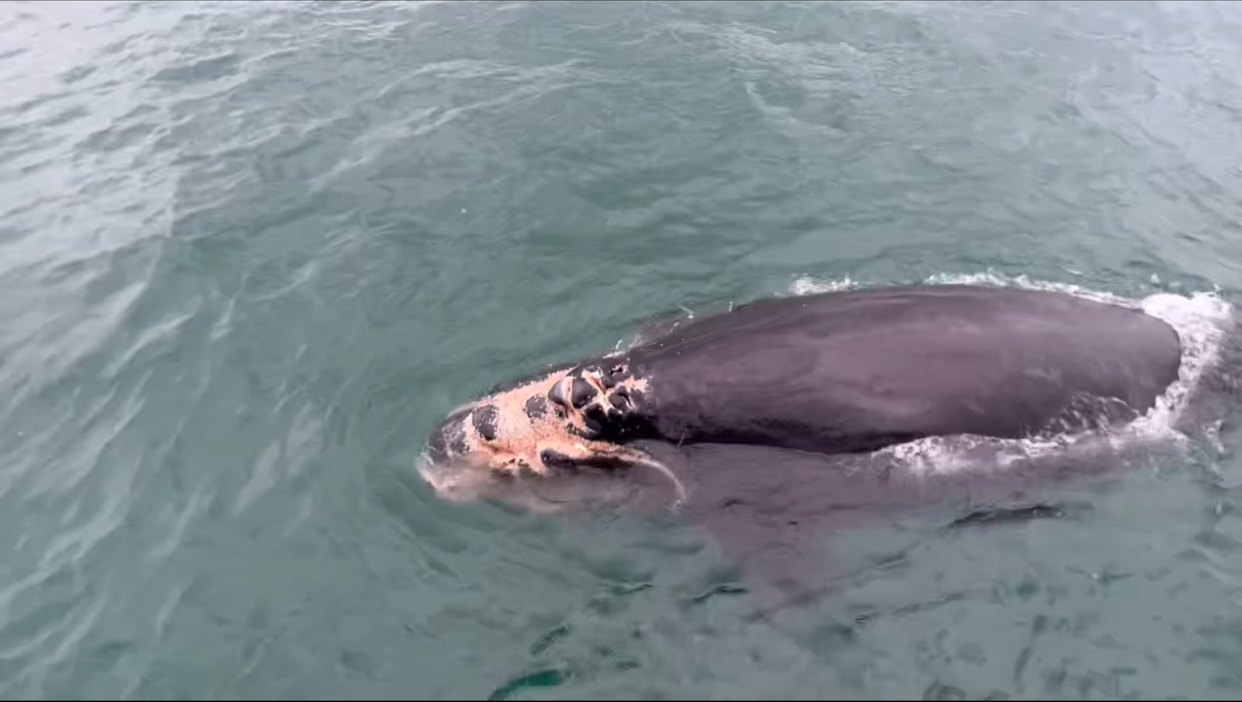North Atlantic right whale calf expected to die from suspected vessel strike off SC coast

An endangered North Atlantic right whale calf suffered potentially fatal injuries after an apparent collision with a vessel off Edisto Island, South Carolina, federal officials said Wednesday.
The calf was spotted Jan. 3, the National Oceanic and Atmospheric Administration Fisheries division reported.
"Videos shared by the public on social media show several propeller wounds on the head, mouth and left lip of the calf consistent with a vessel strike,” NOAA said in an announcement Wednesday. “These injuries may impact this calf’s ability to nurse successfully.”
The incident comes as NOAA considers expanding seasonal offshore speed restrictions for vessels aimed at protecting right whales in their annual birthing area along the Southeast coast.
Five of the eight mother-and-calf pairs identified so far this season were spotted off the Georgia coast, according to the website whalemap.org.
Current federal regulations set a speed limit of 10 knots (11.5 mph) from mid-November to mid-June for vessels at least 65 feet long in a protective zone stretching from Brunswick to Wilmington, North Carolina.
NOAA has proposed applying the regulations to craft 35 feet or longer.
According to NOAA statistics, 40% of right whale strikes involve boats in the 35 to 65-foot range.
“Blunt force trauma, lacerations and death are likely outcomes of a collision with a vessel,” said Dr. Sarah Sharp, animal rescue veterinarian at the International Fund for Animal Welfare. “Vessels of all sizes are at risk of harming the critically endangered right whale.”
Two international research studies determined that limiting speeds to 10 knots led to an 80-90% reduction in whale deaths caused by vessel collisions, NOAA noted in supporting data for its proposed changes.
Rising Temps: Savannah has gotten 2 degrees warmer this century; thank climate change
COP 28: Buddy Carter takes his place at the climate table at COP 28
'Not what we need'
In the last six years alone, there have been a dozen confirmed North Atlantic right whale fatalities from vessel strikes, and 36 deaths have been recorded overall, according to NOAA Fisheries.
Any premature loss threatens the prospective recovery of right whales, which have been protected for a half-century under the Endangered Species Act and the Marine Mammal Protection Act.
The Atlantic teemed with as many as 21,000 right whales before their population was decimated by commercial whaling in the late 19th century, driving their numbers down to an estimated 100.
There are believed to be about 340 remaining, including fewer than 70 reproducing females.
Just a dozen calves were identified during the 2022-2023 season, but not all of them survived.
As for the eight spotted so far this season, “That’s below average and not what we need to bring the species back,” said Gib Brogan, fisheries campaign director at the advocacy organization Oceana. “But anytime we see that there are calves, it shows that they’re finding their way.”
A recently released report by Oceana found that 85% of watercraft at least 65 feet in length exceeded the maximum of 10 knots during the 2021-2022 birthing season.
Danger to Port of Savannah 'river pilot' boats?
Opponents of the proposed 35-foot standard for in-season speed limits include the Georgia Ports Authority, which argues that they would make "river pilot” boats unsafe.
In Savannah, the pilots steer cargo ships along the potentially precarious 25-mile river route from the Atlantic Ocean to the port. But to do that, they need to get to and from the vessels when they’re still at sea.
That means cruising through the whale conservation zones, where the proposed 10-knot limit would apply to boats designed to cruise at twice that speed, said Jamie McCurry, GPA’s chief administrative officer.
“Going slower makes them unstable, especially in rough seas,” he explained.
The pilots, experts in the intricacies of navigating rivers leading to the ports, are considered an irreplaceable element in the operation of GPA facilities.
“NOAA’s proposed rule change would carry with it increased safety risk to vessels and crew during inclement weather – including the possibility cargo ships could be blown off course,” McCurry said. “This increased risk would have prudent river pilots delaying vessel transits, leading to ships anchoring offshore for extended periods or skipping calls along much of the East Coast in favor of longer, less efficient and more costly routes.”
But Oceana’s Brogan countered that situational safety exceptions included in the proposed updates fully address GPA’s concerns.
“With this improved nuance to the rule that provides for rough weather and other conditions, blanket exemptions and exceptions are not warranted and (would) undermine the intended positive outcomes of the new rule,” he explained.
As for the recently observed calf, NOAA Fisheries biologists made a preliminary determination that it meets the criteria of a “serious injury.”
"This means the whale is likely to die as a result," the agency said. "We will continue to work with authorized responders to monitor this calf and further document its injuries."
John Deem covers climate change and the environment on the Georgia coast. He can be reached at jdeem@gannett.com.
This article originally appeared on Savannah Morning News: Right whale calf expected to die from suspected vessel strike

